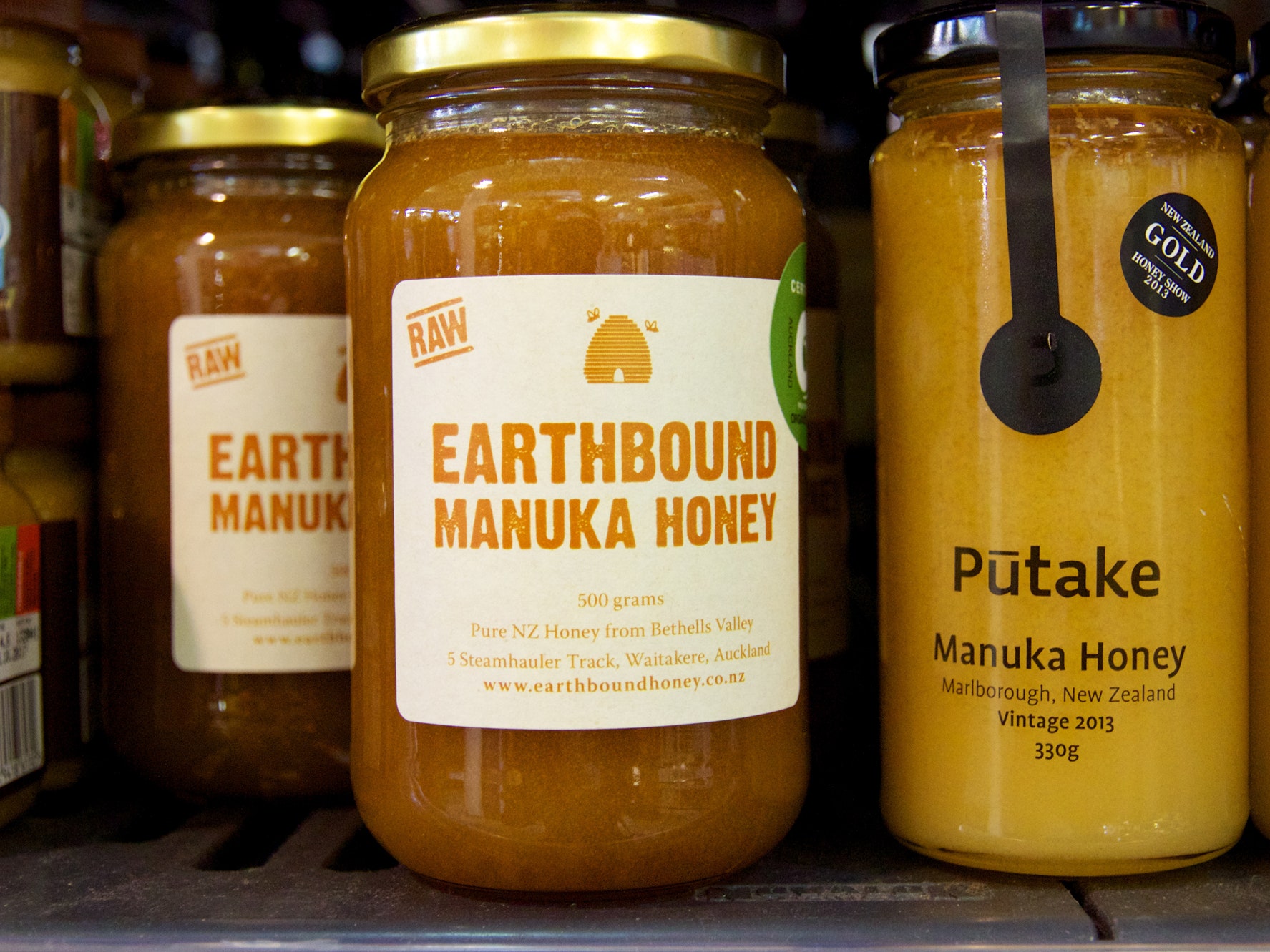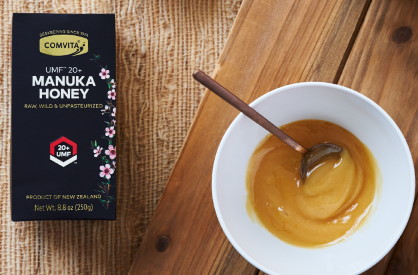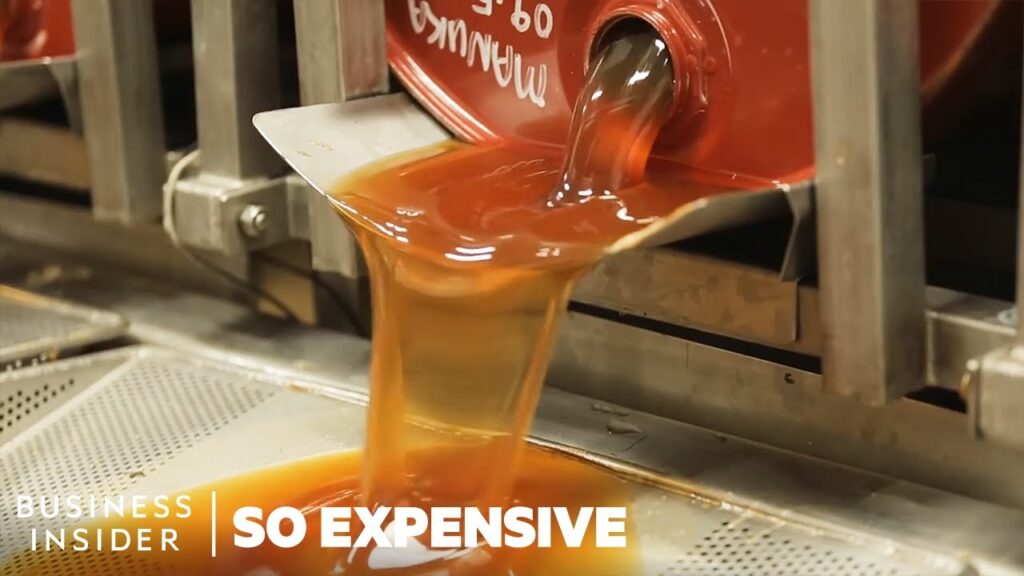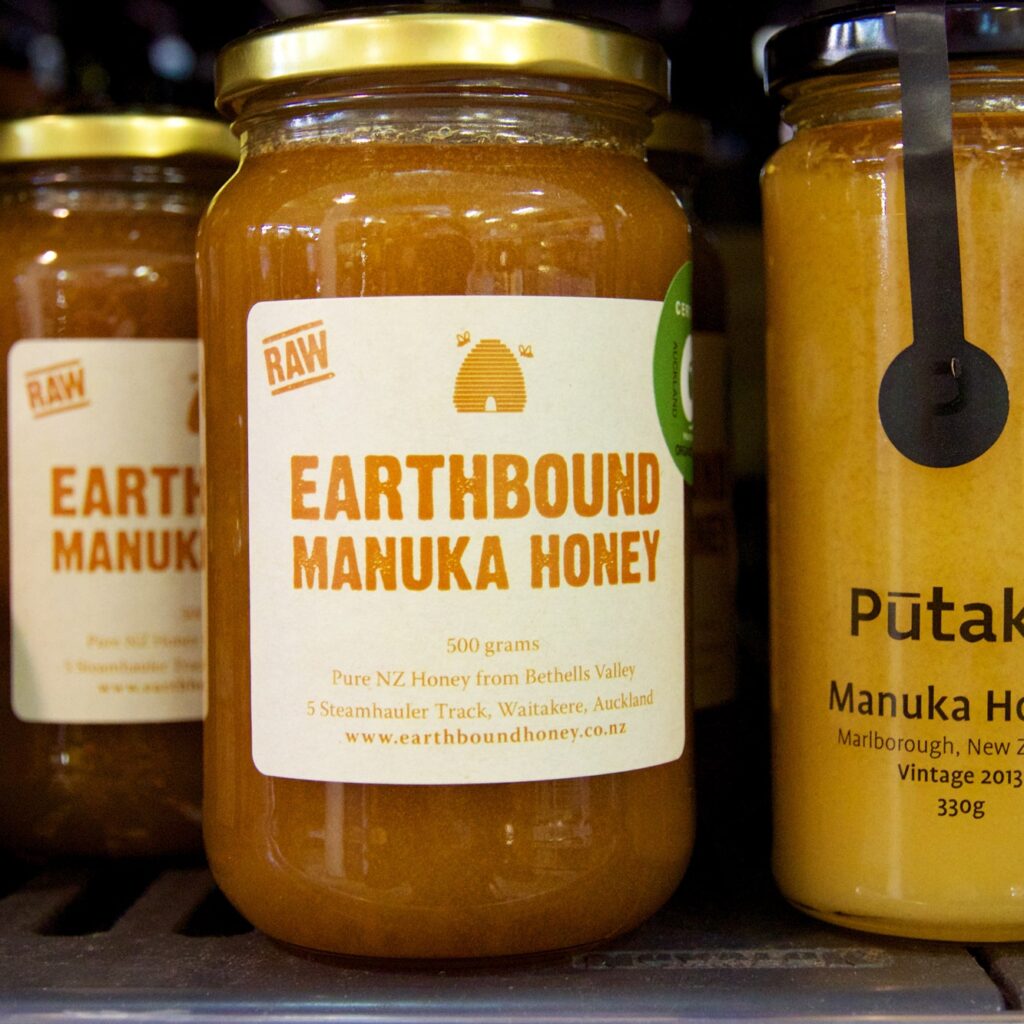
If you’ve ever wondered why manuka honey comes with a hefty price tag, you’re not alone. The demand for this particular type of honey has skyrocketed in recent years, causing its price to soar. But what exactly makes manuka honey so expensive? In this article, we’ll uncover the factors behind its high price and explore the unique properties that set it apart from regular honey. Whether you’re a health enthusiast or simply curious about this golden elixir, get ready to delve into the world of manuka honey and discover why it’s worth every penny.
What is Manuka Honey?
Manuka honey is a type of honey that is produced by bees that gather nectar from the Manuka tree, also known as Leptospermum scoparium. This unique honey is renowned for its distinctive taste and numerous health benefits. It is primarily produced in New Zealand and has gained popularity worldwide for its antibacterial properties and other therapeutic effects.
Definition of Manuka Honey
Manuka honey is a specialized type of honey that is sourced from the nectar of the Manuka tree. It is known for its dark color, thick consistency, and strong, unique flavor profile. Unlike regular honey, Manuka honey contains specific chemical components that give it its exceptional properties. These components, including methylglyoxal (MGO) and dihydroxyacetone (DHA), are responsible for the antibacterial and healing qualities of Manuka honey.
Unique Properties of Manuka Honey
Manuka honey stands apart from other types of honey due to its unique properties. One of its most notable features is its high level of antibacterial activity. This is attributed to the presence of MGO, which is formed from the conversion of DHA in the honey. MGO has been found to exhibit strong antimicrobial effects and help fight against a wide range of pathogens, including antibiotic-resistant bacteria.
In addition to its antibacterial properties, Manuka honey also possesses anti-inflammatory effects. It has been shown to reduce inflammation in the body, making it beneficial for individuals with conditions such as sore throat, sinusitis, and gastrointestinal disorders. Furthermore, Manuka honey has been recognized for its wound healing and skin care properties, making it a popular choice for treating wounds, burns, and skin conditions.
Moreover, Manuka honey has been found to support digestive health by promoting the growth of beneficial gut bacteria and aiding in the management of digestive disorders such as acid reflux and gastritis. It is also believed to have immune system-boosting effects, helping to strengthen the body’s defenses against illness and infection.
Factors that Influence the Cost of Manuka Honey
The high cost of Manuka honey can be attributed to several key factors that influence its production and availability in the market.
Limited Supply and High Demand
One of the primary factors driving up the cost of Manuka honey is its limited supply and high demand. The Manuka tree, from which the bees gather nectar, is native to New Zealand and grows in relatively small areas. This limited geographic range, coupled with the seasonal nature of Manuka tree flowering, restricts the quantity of Manuka honey that can be produced each year. As a result, the demand for Manuka honey far exceeds its supply, leading to higher prices in the market.
Harvesting Challenges
Harvesting Manuka honey poses unique challenges compared to other types of honey. The Manuka tree blooms for a short period, typically only a few weeks each year. During this time, beekeepers must carefully time their honey collection to ensure that the bees have gathered nectar mainly from the Manuka tree’s flowers. This specific sourcing of nectar requires precision and a deep understanding of the flowering patterns of the Manuka tree.
Additionally, the Manuka tree can grow in rugged and remote landscapes, making it difficult to access the hives and collect honey. Beekeepers often face logistical challenges in transporting their hives to these remote locations, resulting in increased production costs.
Meticulous Production Process
the production process of Manuka honey is more complex and time-consuming than that of regular honey. After the honey is collected from the hives, it undergoes a meticulous process to ensure its quality and purity. This may involve careful filtration, temperature control, and storage techniques. The handling and processing of Manuka honey require precision to preserve its unique properties and maintain its high standards.
Quality Assurance Measures
Manuka honey is subject to stringent quality control measures to maintain its authenticity and ensure it meets certain standards. Independent certification bodies, such as the Unique Manuka Factor (UMF) Honey Association, play a crucial role in verifying the quality and authenticity of Manuka honey. These organizations test the honey for its chemical composition, including MGO content, and assign a grading system to indicate its potency and purity. These quality assurance measures add to the production costs and subsequently contribute to the higher price of Manuka honey in the market.

Manuka Honey Grading Systems
Manuka honey is graded based on two primary systems: UMF (Unique Manuka Factor) rating and MGO (Methylglyoxal) content.
UMF (Unique Manuka Factor) Rating
The UMF rating is a grading system that measures the unique properties and strength of Manuka honey. It is an internationally recognized standard that assigns a numerical value to indicate the level of beneficial compounds, particularly MGO, present in the honey. A higher UMF rating signifies a higher concentration of these compounds and, therefore, a more potent and valuable honey. The UMF rating system offers consumers a reliable way to compare and choose Manuka honey based on its quality and efficacy.
MGO (Methylglyoxal) Content
MGO content is another commonly used grading system for Manuka honey. MGO is one of the key chemical compounds that contribute to the antibacterial activity of Manuka honey. The MGO content of Manuka honey is measured in milligrams per kilogram (mg/kg) or parts per million (ppm). The higher the MGO content, the more potent and valuable the honey is considered to be. This rating system provides consumers with an alternative measure to assess the quality and potency of Manuka honey.
It is worth noting that both the UMF rating and MGO content can vary among different brands and batches of Manuka honey. Therefore, it is essential to look for reputable brands that adhere to strict quality control measures and display the UMF or MGO rating on their packaging.
Health Benefits Associated with Manuka Honey
The consumption and use of Manuka honey have been associated with several health benefits due to its unique properties and chemical composition.
Antibacterial Properties
One of the most well-known health benefits of Manuka honey is its strong antibacterial activity. The presence of MGO and other compounds in Manuka honey gives it the ability to inhibit the growth of harmful bacteria. This antibacterial action can help combat infections and prevent the formation of biofilms, which are communities of bacteria that can be resistant to antibiotics.
Manuka honey has been studied for its effectiveness against various strains of bacteria, including Staphylococcus aureus and Helicobacter pylori. It has even shown promise in fighting antibiotic-resistant bacteria, such as MRSA (Methicillin-resistant Staphylococcus aureus). The antibacterial properties of Manuka honey make it a valuable natural remedy for sore throats, colds, and other bacterial infections.
Anti-inflammatory Effects
In addition to its antibacterial properties, manuka honey possesses anti-inflammatory effects. It has been found to reduce inflammation in the body, which can help alleviate symptoms of conditions such as sinusitis, bronchitis, and inflammatory bowel disease. The anti-inflammatory action of Manuka honey is attributed to various compounds, including flavonoids and phenolic acids, which possess antioxidant and anti-inflammatory properties.
Wound Healing and Skin Care
Manuka honey has long been used for its wound healing and skin care properties. Its ability to promote tissue regeneration and inhibit bacterial growth makes it an effective natural remedy for wounds, burns, and skin conditions such as acne and eczema. The antibacterial properties of Manuka honey help prevent infections, while its anti-inflammatory effects reduce swelling and redness, promoting faster healing. Furthermore, Manuka honey’s natural humectant properties enable it to retain moisture and hydrate the skin, making it useful for dry and dehydrated skin.
Digestive Health
The consumption of Manuka honey has been associated with various benefits for digestive health. It is believed to have a soothing effect on the digestive system, helping to alleviate symptoms of acid reflux, gastritis, and stomach ulcers. Manuka honey may also promote the growth of beneficial gut bacteria while inhibiting the growth of harmful bacteria. The prebiotic properties of Manuka honey nourish the gut microbiome, contributing to overall digestive wellness.
Immune System Support
Manuka honey’s potential immune system-boosting effects make it a valuable inclusion in a healthy diet. The antimicrobial and anti-inflammatory properties of Manuka honey help strengthen the body’s immune response, making it better equipped to fight off infections and illnesses. Regular consumption of Manuka honey may support overall immune health and enhance the body’s natural defense mechanisms.

The Importance of Beekeeping Practices
Beekeeping practices play a crucial role in the quality and composition of Manuka honey. Several key factors impact the production of high-quality Manuka honey.
Foraging Environment
The foraging environment plays a significant role in the quality and authenticity of Manuka honey. The Manuka tree relies on specific environmental conditions, such as ample sunlight, suitable soil, and clean air, to produce high-quality nectar. Beekeepers need to ensure that their hives are located in areas where the Manuka tree flourishes, thereby guaranteeing that the honey is sourced from the correct nectar.
Manuka honey’s distinctive properties are influenced by factors such as the climate, soil composition, and surrounding flora. Bees that have access to a diverse and healthy foraging environment produce honey that is rich in beneficial compounds and displays the unique characteristics of Manuka honey.
Extraction and Processing Methods
The extraction and processing methods employed by beekeepers significantly impact the quality of Manuka honey. Careful handling and processing techniques are necessary to preserve the integrity of the honey and prevent any degradation of its beneficial compounds. Gentle extraction methods that minimize heat exposure and avoid excessive filtration help retain the unique properties of the honey.
Additionally, the storage and packaging of Manuka honey should be done in a manner that protects it from degradation due to light, heat, and air exposure. These measures ensure that the honey retains its potency and quality until it reaches the consumer.
Sustainable Beekeeping Practices
Sustainable beekeeping practices are essential for the long-term viability of the Manuka honey industry and the overall health of bee populations. Beekeepers play a vital role in maintaining the balance between honey production and the conservation of bee habitats. By employing sustainable practices, beekeepers can ensure the well-being and preservation of bees, which are crucial for pollination and ecosystem balance.
Sustainable beekeeping practices include providing bees with adequate nutrition, creating suitable habitats, and minimizing the use of pesticides and chemicals that can harm bee populations. By prioritizing the health and welfare of bees, beekeepers contribute to the production of high-quality and authentic Manuka honey.
Regulatory Standards and Certification
The authenticity and quality of Manuka honey are safeguarded by regulatory standards and certification processes. These measures protect consumers from counterfeit products and ensure that they are purchasing genuine Manuka honey.
Official Testing and Certification
Certification bodies, such as the Unique Manuka Factor (UMF) Honey Association in New Zealand, have established rigorous testing and certification processes to verify the authenticity of Manuka honey. These organizations test the honey for specific markers, including MGO content and other chemical compounds, to determine its quality and purity. Manuka honey that meets the criteria set by these certification bodies is labeled with the UMF logo or another recognized certification mark, guaranteeing its authenticity and quality.
Consumers can look for these certification marks on Manuka honey products to ensure that they are purchasing genuine and high-quality honey. It is important to note that the UMF rating or MGO content alone may not be sufficient to determine the authenticity of Manuka honey. The presence of a reputable certification mark provides additional assurance of its quality.
Protecting Consumers from Counterfeit Products
Due to the high demand and premium price of Manuka honey, there has been an increase in counterfeit or adulterated products in the market. These products may claim to be Manuka honey but do not meet the stringent quality standards or contain the beneficial compounds found in authentic Manuka honey. To protect consumers from purchasing counterfeit products, regulatory authorities and certification bodies continuously monitor the market and take legal action against fraudulent practices.
Consumers can protect themselves by purchasing Manuka honey from reputable suppliers and looking for official certification marks. It is advisable to research the company and check for any additional quality certifications or independent testing reports that further validate the authenticity and quality of the Manuka honey.

Alternative Honey Options
While Manuka honey is highly valued for its unique properties, there are alternative honey options available for individuals who may be looking for different flavors or price points.
Clover Honey
Clover honey is a widely available type of honey that is produced from the nectar of clover flowers. It has a smooth and mild flavor profile, making it a popular choice for everyday use. Clover honey is generally less expensive compared to Manuka honey, making it a more budget-friendly option. While it does not possess the same antibacterial or therapeutic properties as Manuka honey, it still offers its natural sweetness and can be enjoyed as a natural sweetener or in various recipes.
Manuka Honey Blends
To make Manuka honey more accessible to a wider market, some producers offer Manuka honey blends. These blends are created by combining Manuka honey with other types of honey, such as clover or wildflower honey. This mixing process allows for a more affordable honey option that retains some of the unique flavors and properties of Manuka honey. While the potency of the active compounds may be reduced in these blends, they still offer a distinct taste and few of the potential health benefits associated with Manuka honey.
Consumers who are interested in the distinctive properties of Manuka honey but have budget constraints may consider exploring these alternative honey options.
Exploring Manuka Honey Products
The increasing popularity of Manuka honey has led to the development of various Manuka honey products that cater to different preferences and needs. These products offer convenient ways to enjoy the unique properties of Manuka honey beyond its traditional use as a sweetener.
Manuka Honey Jars
Manuka honey is commonly packaged and sold in jars of various sizes. These jars contain pure, unprocessed Manuka honey that can be used as a natural sweetener or enjoyed on its own. Manuka honey jars often indicate the UMF or MGO rating, allowing consumers to choose a product that aligns with their desired potency.
Manuka Honey Supplements
Manuka honey supplements, such as capsules or tablets, provide an alternative way to consume the beneficial compounds found in Manuka honey. These supplements are typically standardized to contain specific amounts of active compounds, such as MGO, making it convenient for individuals seeking targeted health benefits. Manuka honey supplements can be particularly useful for those who prefer a consistent dosage or have difficulty consuming honey in its pure form.
Manuka Honey Skincare Products
The skin care industry has embraced the beneficial properties of Manuka honey, leading to the development of various skincare products that feature Manuka honey as a key ingredient. These products, including facial masks, creams, and balms, harness the antibacterial and skin-healing properties of Manuka honey to promote healthy and radiant skin. Manuka honey skincare products can be beneficial for individuals with acne, dry skin, or other skin conditions, offering a natural and nourishing alternative to conventional skincare products.

The Future of Manuka Honey
The future of Manuka honey encompasses sustainable production practices, ongoing research and development, and its potential expansion into new markets.
Sustainable Production Practices
As the demand for Manuka honey continues to rise, it is essential to ensure the long-term sustainability of its production. This involves promoting sustainable beekeeping practices, protecting and preserving the natural environments where Manuka trees thrive, and maintaining the health and well-being of bee populations. Collaboration between beekeepers, environmental organizations, and regulatory bodies is crucial in establishing guidelines and promoting sustainable practices that safeguard the quality and authenticity of Manuka honey.
Research and Development
Ongoing research and development are vital for further understanding the properties and potential applications of Manuka honey. Scientific studies continue to explore the antibacterial, anti-inflammatory, and wound healing properties of Manuka honey, shedding light on its mechanisms of action and identifying new therapeutic avenues. Research efforts also aim to validate the efficacy of Manuka honey in various medical and health-related fields, further bolstering its reputation as a valuable natural remedy.
Additionally, the development of innovative Manuka honey-based products, such as medical dressings, oral care products, and dietary supplements, holds promise in expanding the utilization of Manuka honey beyond its current applications. Continued investment in research and development will drive the future growth and diversification of the Manuka honey industry.
Conclusion
Manuka honey is a unique and highly valued honey that offers a range of health benefits and therapeutic properties. Its limited supply, meticulous production process, and demanding quality control measures contribute to its higher cost compared to other types of honey. Manuka honey’s antibacterial, anti-inflammatory, and wound healing properties make it a sought-after natural remedy for various health conditions.
Consumers should look for reputable brands that display a recognized certification mark, such as the UMF logo or MGO rating, to ensure they are purchasing genuine Manuka honey. Alternative honey options, such as clover honey or Manuka honey blends, provide alternatives for individuals with different preferences or budget constraints.
The future of Manuka honey lies in sustainable production practices, ongoing research and development, and the exploration of new applications. By prioritizing the health and well-being of bees, protecting the environment, and furthering scientific knowledge, the Manuka honey industry can continue to thrive while providing consumers with high-quality and authentic honey.
